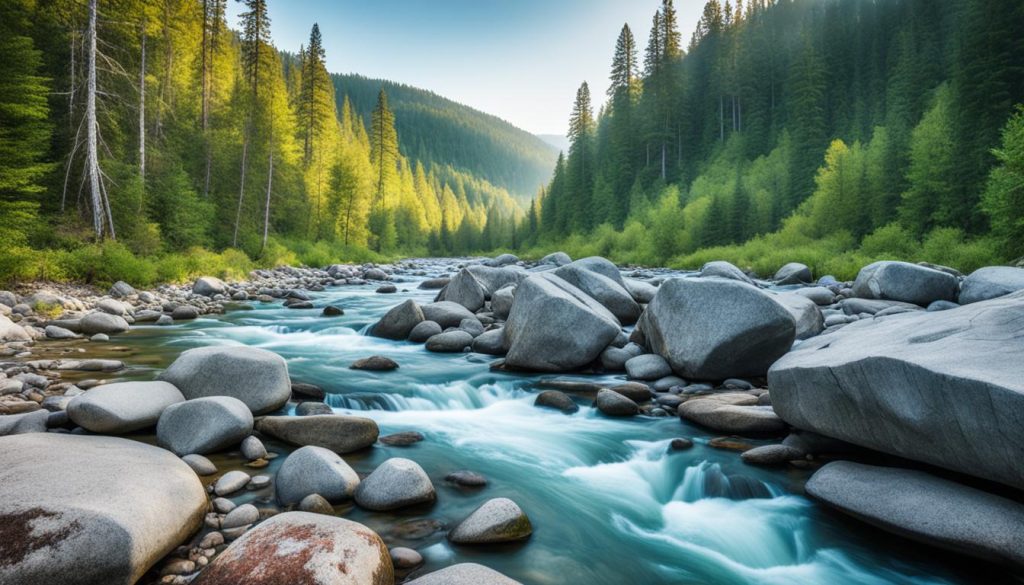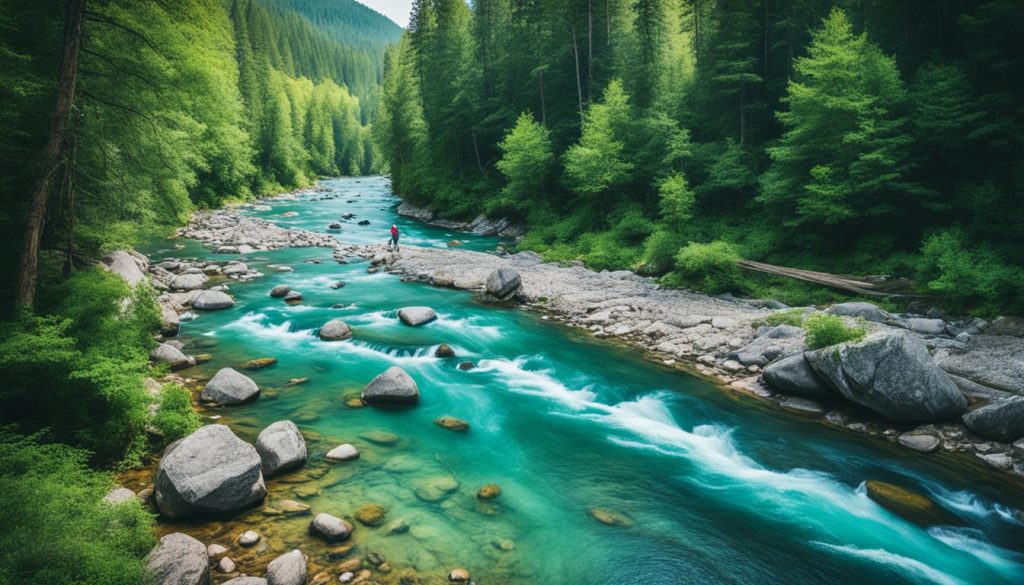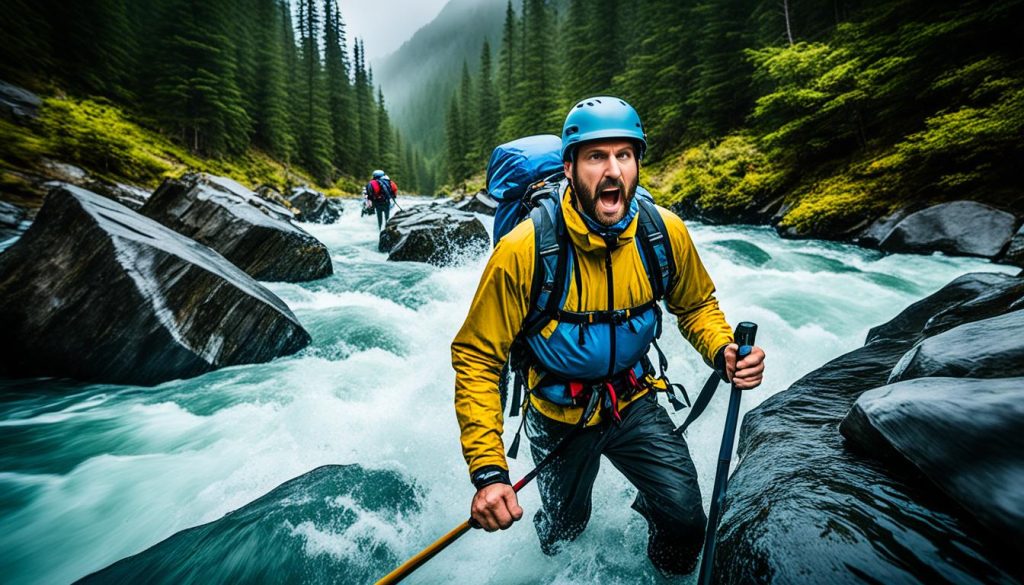Did you know that over 80% of outdoor enthusiasts encounter water crossings during their wilderness adventures? Whether you are hiking through remote trails or exploring untouched landscapes, navigating rivers and streams is a common challenge that requires careful planning and technique.
When facing water crossings in the wild, it is important to have the knowledge and skills to ensure a safe and successful journey. In this article, I will share essential tips and techniques for safely navigating water crossings in the wilderness, drawing from expert advice and real-world experiences.
Key Takeaways:
- Proper planning and preparation are crucial for safely navigating water crossings in the wilderness.
- Choosing the right crossing point can significantly impact the safety and success of your water crossing.
- Assessing the properties of the water, such as depth and current, is essential before attempting a crossing.
- Employing proper crossing techniques, such as using trekking poles for balance, can enhance your safety and stability.
- Remember to prioritize safety, wear appropriate footwear, and be aware of changing water conditions.
Importance of Planning and Preparation
Proper planning and preparation are essential when it comes to safely navigating water crossings in the wilderness. To ensure a successful and safe outdoor experience, it is crucial to pack necessary items and take necessary precautions. Here are some key considerations:
Pack the Essentials in Waterproof Bags
When crossing rivers on hiking trails or exploring water routes in the wilderness, it is important to keep your belongings dry in case of a fall. Pack essential items such as fire starters, sleeping bags, and clothes in waterproof bags. This will help protect your gear and keep you prepared for unexpected situations.
Bring the Right Gear
Additional preparations may include bringing spare shoes for crossing, wool socks for warmth, and shorts for ease of movement. A hiking pole or sturdy stick can provide balance and stability during river crossings. Safety items such as coiled rope and personal flotation devices should also be considered to ensure your safety and the safety of others.
Stay Informed and Have a Backup Plan
Prior to your wilderness exploration, it is crucial to check with park rangers or guides for current river conditions. They can provide valuable information about water levels, currents, and any potential hazards. Having a backup plan or alternate routes in case the water is too high or swift to cross is also advisable.
Choosing the Right Crossing Point
Selecting the right crossing point is crucial for a safe and successful water crossing during backpacking trips in the wilderness. When choosing where to cross a river, there are several factors to consider to ensure a smooth and secure journey.
1. Look for Straight Sections with Slower Currents
When assessing potential crossing points, prioritize straight sections of the river with slower currents. These areas offer more stability and reduced risk compared to bends or areas with fast-flowing water. By selecting a crossing point in a straight section, you’ll have better control over your movements and encounter less resistance from the current.
2. Avoid Crossing Near Bends in the River
Steer clear of crossing near bends in the river, as the current tends to be stronger on the outside of the bend. The force of the water can make crossing more challenging and increase the risk of instability and accidents. Instead, opt for areas that provide a more direct and manageable path across the river.
3. Route Selection: Wider Channels and Multiple Smaller Channels
Choosing a route through wider channels or areas with multiple smaller channels can significantly enhance safety during a water crossing. The water in wider channels is generally shallower and slower, making it easier to traverse. Additionally, multiple smaller channels can create natural stepping stones that allow for more secure footing and stability.
4. Utilize Islands and Sandbars as Crossing Points
Islands or sandbars present in the middle of a river can serve as advantageous crossing points. These formations often provide a more accessible path across the water. By strategically using islands or sandbars, you can break up the crossing into smaller, manageable sections, reducing the overall difficulty of the crossing.
By following these guidelines and carefully selecting the right crossing point, you can increase your chances of safely navigating rivers and streams during backpacking trips in the wilderness.
Assessing the Water’s Properties
Before attempting a water crossing, it is crucial to assess the properties of the natural water obstacles. Understanding the characteristics of the river or stream can help you make informed decisions and minimize risks. Here are some tips for assessing the water’s properties:
-
Observe the Speed of the Water: Take note of how fast the water is flowing. Fast-moving currents indicate deeper and potentially hazardous areas. Swift currents can also make it more challenging to maintain balance while crossing.
-
Look for Standing Waves or Ripples: Standing waves or ripples can reveal hidden rocks or submerged hazards. These areas may pose a risk, especially if the water is too swift or the waves are strong. Avoid crossing through areas with significant waves or turbulence.
-
Test the Depth: Tossing a stick or rock into the water can provide insights into its depth. It is recommended to avoid crossing through water that is deeper than knee-deep if possible. Deeper crossings can increase the risk of losing stability and getting swept away by the current.
-
Seek Flat Pools with Little or No Current: Look for calm, flat pools within the river where the water is relatively still. These areas offer safer crossing points as they have less current and lower risk of being carried downstream.
Always be aware of hazards downstream, as getting swept away by the current can be extremely dangerous. Having a rescue plan in place is essential for emergencies.
Example: Assessing the Water’s Properties
“As I approached the river, I carefully observed the speed of the water. The strong current indicated deeper sections and potential hazards. I noticed standing waves in certain areas, indicating rough terrain beneath the surface. Taking this into consideration, I decided to avoid those areas and looked for safer crossing points with minimal waves. To gauge the depth, I tossed a rock and measured how long it took to hit the bottom. Additionally, I found a calm, flat pool downstream that offered a more manageable crossing point. Assessing the water’s properties allowed me to make informed decisions and navigate the river safely.”
| Properties to Assess | Factors to Consider |
|---|---|
| Speed of the Water | Fast currents indicate deeper areas and increased difficulty. |
| Standing Waves or Ripples | These can indicate hidden hazards or strong currents. Avoid areas with significant waves or turbulence. |
| Depth of the Water | Crossing through water deeper than knee-deep can be risky. Look for shallower areas whenever possible. |
| Flat Pools with Little or No Current | Calm, flat pools provide safer crossing points with reduced current and lower risks. |
Techniques for Crossing Safely
When it comes to crossing streams safely in the wilderness, employing the right techniques is essential. By following these tips, you can navigate water crossings with confidence and minimize any potential risks or accidents.
Use Trekking Poles or Sturdy Sticks for Balance and Stability
One of the most effective techniques for crossing streams safely is to use trekking poles or sturdy sticks for balance and stability. These tools provide extra support and help you maintain your footing on uneven or slippery surfaces. By distributing your weight more evenly, you can enhance your stability and reduce the risk of stumbling or falling.
Maintain Two Points of Contact with the Stream Bottom
To ensure optimal stability while crossing a water obstacle, it is crucial to maintain two points of contact with the stream bottom at all times. This means keeping both feet firmly planted on the ground while moving forward. By doing so, you increase your stability and reduce the chances of being swept away by the current.
Move Diagonally Downstream to Go With the Current
When crossing a river or stream, it is generally safer to move diagonally downstream, going with the current instead of against it. This technique helps you maintain balance and minimize resistance. By moving at an angle, you reduce the force of the water pushing against you, making the crossing easier and safer.
Utilize the Mutual Support Method When Crossing as a Group
If you’re crossing a water obstacle as part of a group, the mutual support method can enhance safety. In this technique, group members hold on to each other’s shoulders or backpacks and shuffle step together. By staying connected, you provide support and stability to one another, making the crossing a coordinated effort.
Stay Focused on the Far Shore and Avoid Looking Down at the Water
While crossing a river or stream, it’s vital to stay focused on the far shore. This helps maintain your balance and direction. Avoid the temptation to look down at the swirling water, as it can induce dizziness and disorientation. By keeping your eyes fixed on the destination, you’ll navigate the water crossing with greater confidence and safety.
Safety Precautions and Additional Considerations
When crossing rivers in the wilderness, prioritizing safety and taking necessary precautions is essential. Here are some tips to help ensure a safe water crossing:
- Release the waist and sternum belts of your pack to enable quick removal in case of a fall.
- If you do fall in, try to stand back up quickly before your backpack gets too waterlogged.
- It is advisable to keep your footwear on for any substantial river crossings to protect your feet from potential hazards.
- Always be aware of the weather forecast and avoid crossing during or after heavy rain, as it can lead to higher water levels and faster currents.
Keeping these safety precautions in mind can significantly contribute to a safe and successful water crossing in the wild. With proper planning, preparation, and attention to potential hazards, adventurers can navigate water crossings confidently and enjoy their wilderness exploration. Remember, your safety should always be the top priority when venturing into the wilderness.
Conclusion
Successfully navigating water crossings in the wilderness is an essential skill for outdoor adventurers. With proper planning, preparation, and technique, you can safely cross rivers and enjoy your wilderness exploration without compromising your safety. Remember to always prioritize safety and be prepared for changing water conditions.
By following the tips and guidelines discussed in this article, you can confidently tackle outdoor adventure water crossings and discover new wilderness exploration water routes. Stay informed about current river conditions, choose the right crossing points, and assess the properties of the water before attempting a crossing.
Employing techniques such as using trekking poles for balance, maintaining two points of contact with the stream bottom, and moving diagonally downstream can greatly enhance your chances of a successful crossing. Additionally, take safety precautions like releasing your pack’s waist and sternum belts and avoiding crossing during or after heavy rainfall.
Embrace the exhilaration of outdoor adventures in the wilderness while ensuring your safety and well-being. With the right preparations and a focus on safety, you can enjoy the thrill of conquering water crossings and embark on unforgettable wilderness exploration journeys.



